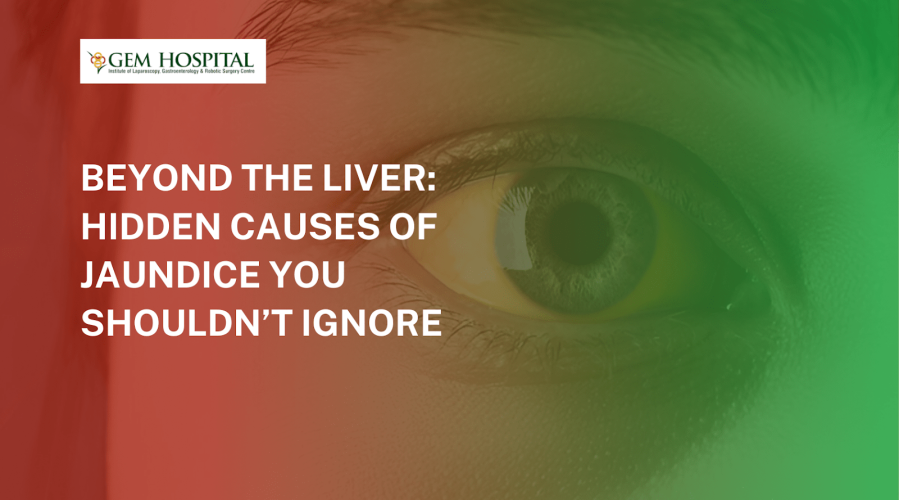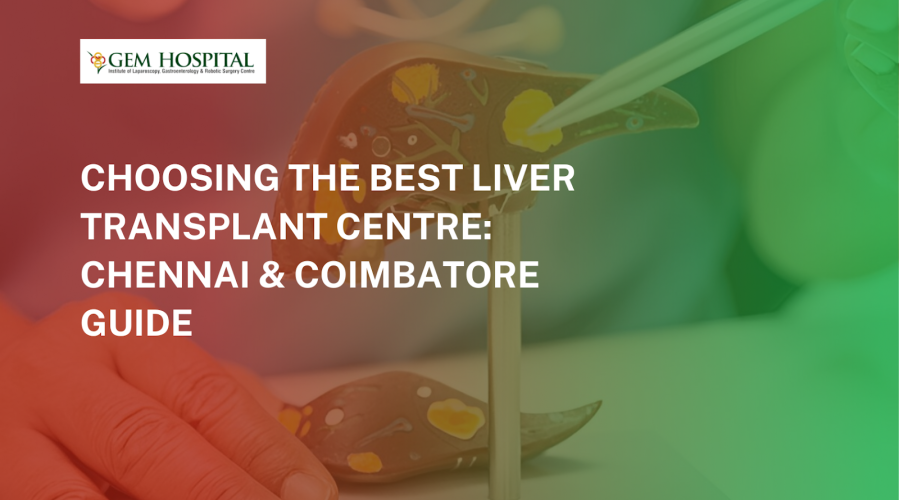Discover the latest advances in liver and kidney treatment at GEM Hospitals in Chennai and Coimbatore. Learn how our cutting-edge care and expert specialists set us apart from other healthcare providers.
Beyond the Liver: Hidden Causes of Jaundice You Shouldn’t Ignore

We typically think of jaundice in terms of liver disease, and rightly so; when the liver is not processing bilirubin properly, jaundice is usually one of the first visible signs we can see, often in the eyes and skin. But what about when jaundice implies something else entirely, or is even unrelated to liver function?
"Jaundice causes beyond liver disease" is an important area of inquiry for physicians. In many other instances of jaundice, there are flags for conditions requiring immediate care, including blood disorders, blockages to the bile ducts, and even some cancers.
In this piece, we will review when jaundice might point to more than liver issues, what else it might signal, and when to seek professional care.
Understanding Jaundice
Jaundice is a condition that results when excessive bilirubin, a usually yellowish pigment in your blood, accumulates in your blood. This can occur either from the body producing too much bilirubin or not processing and eliminating it properly.
When most people think of jaundice they are generally thinking about it in the context of hepatitis, cirrhosis, or liver issues. However, the liver is only one part of the equation. Bilirubin metabolism also involves the blood, gallbladder, bile ducts, pancreas, and other systems in the body.
That is why when jaundice develops, physicians are required to work up not just liver diseases, but other issues as well.
Jaundice Causes Beyond Liver Disease
Here are some common and sometimes overlooked reasons why jaundice may occur even when your liver appears to be functioning normally:
1. Hemolytic Disorders
Sometimes jaundice results from the rapid breakdown of red blood cells, a process called hemolysis which floods the bloodstream with bilirubin.
Conditions that can cause hemolysis include:
- Autoimmune hemolytic anemia
- Sickle cell disease
- Thalassemia
- Certain infections or medications
- Congenital enzyme deficiencies (such as G6PD deficiency)
In such cases, the liver may be healthy but unable to keep up with the excessive bilirubin load.
2. Gallstones and Bile Duct Blockages
If the bile ducts are blocked, bilirubin can't exit the liver properly and begins to build up. Blockages can occur due to:
- Gallstones lodged in the bile duct
- Pancreatic cancer pressing on the bile ducts
- Cholangiocarcinoma (bile duct cancer)
- Benign bile duct strictures after surgery
In these situations, jaundice often develops suddenly and severely, sometimes accompanied by abdominal pain and itching.
3. Pancreatic Conditions
Pancreatic tumors or inflammation (pancreatitis) can compress the bile ducts and lead to jaundice. Even when the liver is working fine, mechanical obstruction causes bilirubin to accumulate.
Sometimes pancreatic head tumors cause “painless jaundice” a serious sign that must be investigated urgently.
4. Genetic Syndromes
Certain inherited conditions affect how bilirubin is processed in the body, causing persistent jaundice. These include:
- Gilbert’s syndrome
- Crigler-Najjar syndrome
These syndromes typically cause mild jaundice and are usually benign, but it’s important to rule out more serious causes.
5. Drug-Induced Jaundice
Some medications can impair bilirubin metabolism or damage bile ducts, triggering jaundice. Examples include:
- Antibiotics (e.g., rifampin, erythromycin)
- Anabolic steroids
- Certain chemotherapies
- Psychiatric medications
If jaundice appears after starting a new medication, notify your doctor immediately.
Key Signs to Watch For
Jaundice is not always accompanied by other symptoms but when it is, those clues can help doctors pinpoint the underlying cause.
Watch for the following:
- Dark urine and pale stools may suggest bile duct obstruction
- Abdominal pain can point to gallstones or pancreatitis
- Severe fatigue or shortness of breath may indicate hemolysis
- Itching commonly linked to bile duct problems
- Weight loss can be a sign of cancer or chronic illness
- Fever and chills could signal infection or inflammation
Diagnosis: Why Expert Evaluation Matters
Because jaundice has so many potential causes, a thorough diagnostic workup is essential. This typically includes:
- Detailed history and physical examination
- Blood tests (bilirubin levels, liver enzymes, blood counts)
- Ultrasound or CT scan of the abdomen
- MRCP (Magnetic Resonance Cholangiopancreatography) for detailed bile duct imaging
- Endoscopy if bile duct obstruction or tumor is suspected
Sometimes a biopsy may be needed to confirm the diagnosis.
Don’t Ignore the Signs Seek Expert Care
While jaundice often starts as a simple yellow tinge in the eyes or skin, it can signal serious and sometimes life-threatening conditions far beyond liver disease. Ignoring it or delaying diagnosis can lead to complications and missed treatment windows.
If you or a loved one notices jaundice especially if it comes with other symptoms like abdominal pain, itching, or fatigue don’t take chances.
Gem Hospital offers comprehensive diagnostic and treatment services for jaundice, liver, pancreatic, bile duct, and hematologic conditions. Our multidisciplinary team uses advanced imaging and minimally invasive techniques to pinpoint the cause and provide the right care.
Book an appointment today with Gem Hospital’s expert gastroenterology and hepatology team and take the first step toward clarity and recovery.
Blogs & Article
Find the best liver transplant centre near you with our comprehensive guide for patients in Chennai and Coimbatore. Learn how to choose a reliable centre for safe and effective treatment.
Compare the cost-effectiveness of kidney treatment versus transplant in Coimbatore and Chennai. Learn which city offers better options for kidney care and transplantation.


